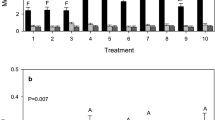Abstract
Rhynchaenus pallicornis (Say) (Coleoptera: Curculionidae) is an economically significant pest of organically produced apples in Michigan. Although R. pallicornis has not been considered a pest of domesticated apples for over 50 years, it has recently reemerged with some organic producers experiencing >90 % yield loss as a result. We evaluated the effect of conventional and US Department of Agriculture: National Organic Program (NOP)-approved insecticides on adult R. pallicornis in the lab. Spinosad was the most effective organic compound tested (95.8 % mortality after 48 h). We then evaluated various application timings and rates of spinosad at commercial orchards. Applications of spinosad timed with the tight cluster stage of apple bud phenology caused the highest mortality of caged adults and significantly reduced the proportion of leaves with larval mines compared to an untreated control. Spinosad application significantly decreased the rate of parasitoid emergence from R. pallicornis larval leaf mines at one research site. The recommended application rate for spinosad in pome fruits is 219 ml/ha. We tested the efficacy of spinosad applied at 219 and 110 ml/ha for control of the summer generation of R. pallicornis. Half-rate applications (110 ml/ha) caused mortality similar to that of full-rate applications (219 ml/ha). Reduced application rates and informed application timings of spinosad may provide effective control of R. pallicornis while mitigating negative impacts on natural enemies.
Similar content being viewed by others
References
Abbott W (1925) A method of computing the effectiveness of an insecticide. J Econ Entomol 18:265–267
Arthurs SP, Lacey LA, Miliczky ER (2007) Evaluation of the codling moth granulovirus and spinosad for codling moth control and impact on non-target species in pear orchards. Biol Control 41:99–109
Cisneros J, Goulson D, Derwent LC, Penagos DI, Hernández O, Williams T (2002) Toxic effects of spinosad on predatory insects. Biol Control 23:156–163
Crowder DW, Northfield TD, Strand MR, Snyder WE (2010) Organic agriculture promotes evenness and natural pest control. Nature 466:109–112
Cutright C (1950) New insecticides for summer control of apple flea weevil. J Econ Entomol 43
Flint WP, SC Chandler, Glenn PA (1924) The apple flea-weevil, Orchestes pallicornis Say (Order Coleoptera; Family Curculionidae). Ill Nat Hist Bull XV
Houser J (1923) The apple flea weevil Orchestes pallioornis Say. Ohio Agric Exp Sta Bull 372:395–454
Lu Y, Wu K, Jiang Y, Xia B, Li P, Feng H, Wyckhuys KA, Guo Y (2010) Mirid bug outbreaks in multiple crops correlated with wide-scale adoption of bt cotton in china. Science 328:1151–1154
Mason P, Erlandson M, Elliott R, Harris B (2002) Potential impact of spinosad on parasitoids of Mamestra configurata (Lepidoptera: Noctuidae). Can Entomol 134:59–68
Mayes, MA, G.D. Thompson, B. Husband, and M.M. Miles. 2003. Spinosad Toxicity to Pollinators and Associated Risk. p. 37–71. In Reviews of Environmental Contamination and Toxicology. Reviews of Environmental Contamination and Toxicology. Springer New York.
Mundinger FG (1951) The apple flea weevil. J Econ Entomol 44:28–33
Nielsen AL, Pote J, Buehrer K, Grieshop MJ (2012) The reemergence of an old pest, Orchestes pallicornis (Coleoptera: Curculionidae). J Integr PestManag 3:D1–D4
Pote J (2014) Biology of the reemergent pest apple flea weevil (Orchestes pallicornis, Say) and methods for its organic control. Masters Thesis, Michigan State University
Zehnder G, Gurr GM, Kühne S, Wade MR, Wratten SD, Wyss E (2007) Arthropod pest management in organic crops. Annu Rev Entomol 52:57–80
Acknowledgments
We would like to thank Ron Perry for his sage advice and assistance in this work. Additionally, we recognize the undergraduate laborers who assisted in data collection—Danielle Boston, Casey Rowley, Sarah Ward, and Matthew Quenaudon—as well as those laborers who volunteered their efforts for the completion of this work—Patrick Quinn and Collin Magin. We would also like to thank Michigan State University’s Project GREEEN for funding this work.
Author information
Authors and Affiliations
Corresponding author
Rights and permissions
About this article
Cite this article
Pote, J.M., Nielsen, A.L., Gut, L. et al. Organic management of apple flea weevil, a reemergent pest of commercial apples. Org. Agr. 6, 203–213 (2016). https://doi.org/10.1007/s13165-015-0129-z
Received:
Accepted:
Published:
Issue Date:
DOI: https://doi.org/10.1007/s13165-015-0129-z




